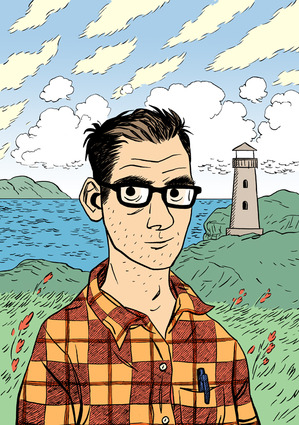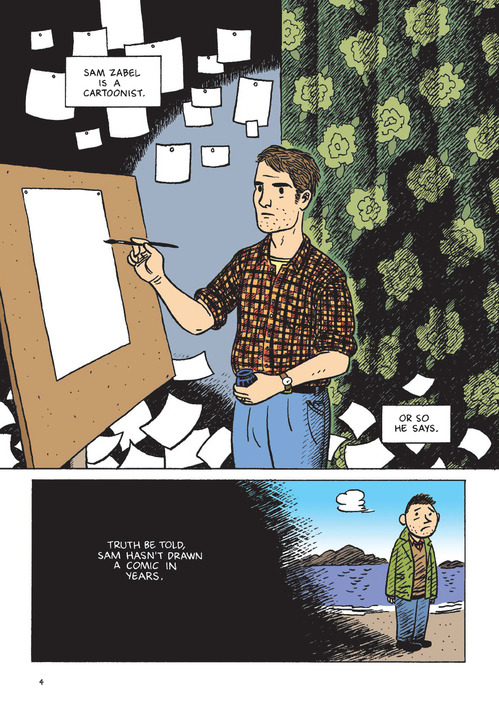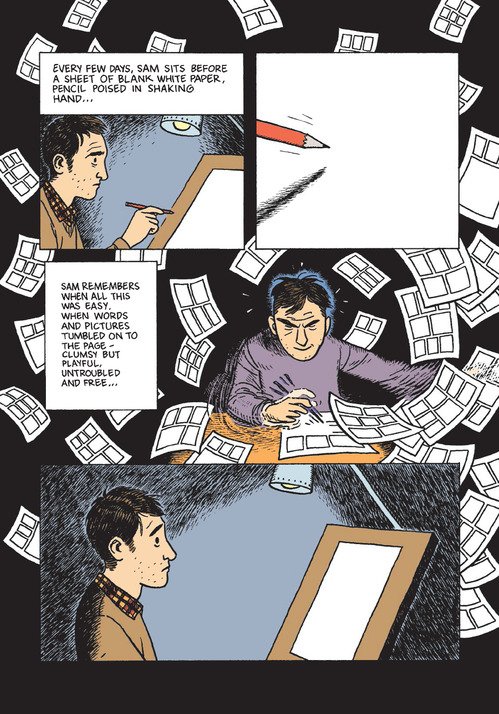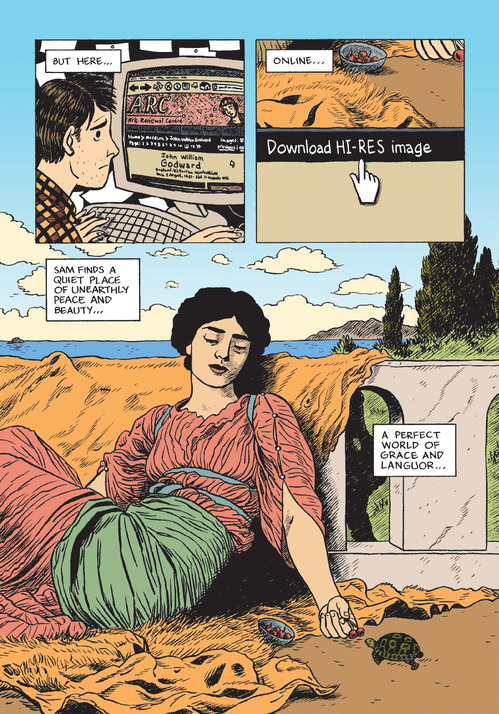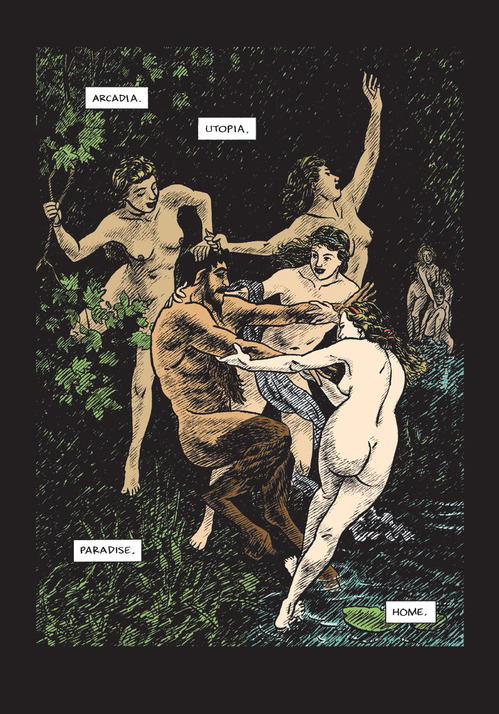After a 17-year absence from graphic novels following 1998’s Hicksville, Dylan Horrocks returns this month with Sam Zabel and the Magic Pen, a book that serves as both an example and exploration of classic wish-fulfillment fantasies. Zabel, a character from Hicksville and clear stand-in for Horrocks, is miserable and depressed, no longer writing his own autobiographical comics. Instead, he works on scripts for Lady Night, a once-thoughtful, philosophical superhero book that’s since degenerated into cheesecake excess. Invited to speak about comics at a literature conference, Zabel encounters a young woman named Alice Brown who requests an interview and, shortly thereafter, the pair finds itself inexplicably transported within the panels of an obscure New Zealand comic set on Mars.
From this point on, the book veers sharply into the surreal with the aid of the titular magic pen, a device that brings anything it draws to life, as well as transport others into the worlds it creates. Zabel embarks on a journey with Brown and another young woman, Miki, through a variety of genre books in search of the pen. The resulting journey transcends the classic cautionary “be careful what you wish for” tale, reflecting on gender politics in comics and how they intersect with fantasy. With Sam Zabel launching later this month, Horrocks chatted with us over email over myriad topics, plus handed down a long list of (tasteful) recommendations for comics you should keep out of your kids’ reach.
The following interview contains content that may be inappropriate for younger readers.
Paste: This book is clearly autobiographical, right? Can you talk about your own experiences and how they played into creating it?
Dylan Horrocks: I started The Magic Pen around 2003 or 2004, after I’d been writing comics for DC for a few years. I enjoyed a lot of the DC work, but sometimes it felt like being trapped inside someone else’s wish-fulfillment fantasy, and over time, my own writing and drawing began to dry up, as though I were losing my voice as a cartoonist. At first, The Magic Pen was just a daydream that crept into my thoughts while I lay in bed waiting to go to sleep. But at a certain point, I started to turn it into a more substantial story — partly as a way of processing what was going on in my head.
Paste: You serialized The Magic Pen on your site over a number of years. Did you know exactly where you were going when you started out? What changed along the way?
Horrocks: The Magic Pen first appeared as a back-up story in Atlas, the comic book series I was doing for Drawn & Quarterly, in 2006. We published two chapters that way, but then it went on hold for a few years before I revived it on the website in 2009.
By the time I started drawing, I had a vague overall plan for the story. But writing, for me, is a process of exploration. I start out with a bunch of questions I want to dig around in; I’m looking for answers, rather than trying to communicate something I already know. So things inevitably change along the way, as new questions or pathways emerge, and I find myself needing to investigate them.
One of the biggest changes that took me by surprise was Miki. In my original plan, Miki was a minor character, very different and a lot less fun. Then one day I was doodling in my sketchbook and there she was: sly, capricious, playful and mysterious. As soon as I let her loose in Sam’s story, she took charge; at times I felt like Sam — holding on for dear life as Miki blasts across the Martian sky in her atomic-powered rocket boots.

Paste: Being able to draw whatever you want is basically a superpower, and I guess you’d say “with great power comes great responsibility.” Your book really opens up a dialogue on that subject. I appreciate that it’s not dogmatic about the issues involved. Can you talk about your approach to laying out those issues? Did your views on the subject change over time?
Horrocks: I really didn’t want to be dogmatic — in fact, I don’t know that I could have been, because I didn’t have a clearly defined position to be dogmatic about. The book is partly a kind of experimental laboratory, where I create a series of situations fraught with moral complexity and then see what happens when I drop certain characters into them. Every now and then, I try taking a clear position, to see how that feels. But I always tried to undermine, question or challenge those positions at the same time — by surrounding them with the very pleasures they were condemning, or by allowing a sense of unease to creep over the reader. I wanted to build a big, fun, slightly-dangerous adventure playground, where I could play around and push my own limits, even if things got a little scary at times. Hopefully a few other people will enjoy playing there too, and if we’re lucky we might learn something about ourselves and each other. Well, that was the idea. But I’ll settle for getting a few laughs.
The central question, in a way, is asked out loud by Sam halfway through: “Do we bear a moral responsibility for our fantasies?” The book sets out to have a conversation about that question. I’m far more interested in hearing other people’s answers, than in trying to offer my own; I want readers to enter into their own conversations with the book, and if I’m lucky I’ll get to eavesdrop on some.
Paste: One work of art that came to mind reading The Magic Pen was Woody Allen’s short story The Kugelmass Episode. Was that an intentional influence? Or do you think this kind of wish fulfillment through art is just a common desire?
Horrocks: I’ve never read it — sorry! But it’s not an unusual idea in fiction (and I remember liking Woody Allen’s Purple Rose of Cairo years ago). When I started writing The Magic Pen, I still had young children (they’re teenagers now), and so I was watching a lot of kids’ movies and TV shows and reading children’s books, and the border between fiction and reality is very porous in a lot of art made for kids. Magic crayons, make-believe characters who come to life, books you can enter, doorways that lead to imaginary worlds — it’s a motif that shows up again and again.
I’m totally fascinated by wish fulfillment fantasies: how they work; their strange familiar contours; the weird mix of yearning, pleasure, embarrassment and shame we feel about them; what happens when they become “property” — a franchise or brand. Obviously, that’s a big part of the history and landscape of comics, but I think it’s also an underrated element in so-called “literary fiction” and “serious” art. The Magic Pen gave me an opportunity to unpack some of my own ambivalence about wish-fulfillment fantasies, but it also helped me find my way back to their power and joy.
Paste: Would you say you experienced the same level of depression as Sam Zabel? I think it’s interesting the way the story about moral responsibility for fantasies is nested inside a sort of journey novel about finding your way back out of depression. Did you write your way out of it?
Horrocks: The opening chapter, “Anhedonia,” pretty accurately shows the depression I experienced, although, of course, there was more to it than that. When I finally acknowledged to myself that I was depressed, I went to the library and got out a mixture of self-help books and memoirs. The main thing I got from those was a sense of recognition (yes, this is depression), and also of hope (you don’t have to keep feeling like this). I gathered my courage and went to the doctor, who prescribed an SSRI (an antidepressant), which was initially disorienting, but helped enormously once we got the dose sorted out. The SSRI gave me a holiday from the worst of it, allowing me the space to start rebuilding my own strategies for moving out of the depression. I don’t know that the medication would have solved things by itself; it’s even possible it served largely as a placebo — a signal to myself that I was doing something to change it. But anyway, it took a while to slowly climb out of the gloom and into the light, and a number of things helped along the way: meditation, writing, drawing, learning to cut myself some slack.
The Magic Pen was definitely part of that. The process of making something new, of starting with a blank piece of paper and physically carving pictures, places and people out of it with ink — that process can feel very calming, healing, pure. The big shift for me was to stop giving myself such a hard time about my work. I had spent years feeling very uncomfortable with my drawing, because it was so clumsy and inept. I tried to draw like other people; the first issue of Atlas (Drawn & Quarterly, 2001) is full of my attempts to draw like Edmond Baudoin, Blutch, Tibor Gergely and other artists I admire. But it’s kind of a mess. The reality is, I can’t draw like other people, I can only draw like me. Luckily, no one else can draw exactly the way I do, either.
Drawing is so physical, so intimate and personal; it’s not simply a matter of transferring what’s in your brain to the page. Instead, it’s a collaboration between your brain, your hand, the pen, the paper — and countless other parts of your body and the environment you’re in at the time. I think I learned to embrace that collaboration — to enjoy what the process brings to the final drawing, and to accept that much of the awkwardness and strangeness I had tried to purge from my work are inflections in my voice. Of course, I work hard at improving my drawing skill, but sometimes I’m forced to recognize that the flaw I’m trying to overcome is not a flaw at all; it’s how I draw. The trick to improving isn’t replacing your voice with another; it’s strengthening your voice — exercising it, building up those drawing muscles, making it stronger and more expressive.
So, long story short, drawing went from being a painful thing, full of doubt and struggle and disappointment, to an act filled with pleasure and joy. That was the best therapy ever. I should say, though, that everyone experiences depression differently, and different things work for different people. The important thing I learned is that you don’t have to put up with it. Get help. Try things. And if the first things you try don’t help, try something else. It can take a few goes to find what works for you, and it might take some time, but it’s totally worth the effort.
Paste: Were there any genres of comics you wanted to include in the books within Sam Zabel that you didn’t get to?
Horrocks: Yes! I even have a couple of episodes from the history of the Magic Pen that I want to draw up as stand-alone stories. War, romance, politics — the pen has seen it all.
Paste: Talk to me about your visual style: why did you choose not to depict the sexual encounters in the book explicitly? To broaden your audience? Just generally uncomfortable with the subject matter? Didn’t fit the focus on older comics?
Horrocks: That’s a complicated question. The most graphic sex scenes were the most difficult sections to draw, and some pages took a few goes before I felt I had the tone right. I’m not at all uncomfortable with the subject matter, unlike Sam! In fact, I’ve drawn much more explicit erotic comics before, and I have plans to draw others. I love really good porn, and by good, I usually mean porn that’s personal, potent, honest. And in earlier versions of some pages, I did go further. But it just didn’t feel right. I still wanted it to be erotic — if it gets readers off, I’ll be very happy. And God knows, I went well beyond the comfort level of some people; I’m dreading some family members seeing it! In the end, it was a matter of finding the tone that felt right. The erotic and the explicit aren’t always the same thing; they interact in a kind of dance. A person’s face in climax can be a hundred times more effective than a close-up penetration shot. But, as always, one person’s turn on is another’s yawn. Maybe one day we’ll do a variant edition….
Paste: Well, heck, while we’re on the subject, how about some recommendations for our readers in the field of porno comics?
Horrocks: Colleen Coover’s Small Favors, Jimmy Beaulieu, Jess Fink, Brandon Graham, M. Magdalene’s Curvy, Thickness, Smut Peddler, Gilbert Hernandez’s Birdland, Frederic Boilet, Ellen Forney, Tom of Finland, Joann Sfar’s Pascin — and so many more. There’s a New Zealand cartoonist named Barry Linton whose work has been a big influence on mine over the years.
Then there are the more old-school, male gaze, European porn cartoonists, like Milo Manara, Guido Crepax, Franco Saudelli, Vittorio Giardino. I often have issues with the gender politics, but I can’t deny the potency of their work. There are moments in Manara’s comics that invoke an almost religious devotion to erotic arousal as a transcendent force. And then there are moments that just make me cringe.
I admire the obsessiveness that characterizes a lot of serious porn cartoonists. Saudelli is a good example: the same motifs return again and again, the fetishistic devotion to specific details in the clothing and accessories or the particular curve of an ankle. I love that kind of obsessive particularity in any art, and it often reaches a whole new level in pornographic art.
That’s also something I enjoy in a lot of manga. I read Masakazu Katsura’s I”s recently, which is pretty dumb and also kind of fucked up, but I love the way Katsura zeroes in on intense, over-heated, adolescent, horny, erotic-romantic obsession and then wallows in its every twisted perverse nuance. Each outfit and gesture and smile or pout is so carefully, painstakingly, lovingly rendered — far beyond the requirements of plot or characterisation. And the same obsessiveness applies to the storytelling, too. There’s a long sequence where the main character is hiding under a blanket with the girl of his dreams, their bodies barely touching, unable to move a muscle, because then he’d be discovered by a teacher. This moment goes on and on, as his awareness of her breasts and legs and skin grows and he grows more and more uncomfortable and aroused. That feeling of time slowing down, of holding your breath, of the temperature rising… and then the moment passes— but only after staying with that moment for some ten or so pages.
I’m also fascinated by the presence of the erotic in non-porno comics — in the way a body is drawn, or a face, the attention paid to clothing or the sensual texture of landscapes and interiors. Desire making itself visible…
Paste: Maybe this is a dumb question, but what do you think you’d do if you came across such a pen?
Horrocks: In a way, Sam Zabel and the Magic Pen is me trying to answer that question. But in reality, I’d probably spend the rest of my life trying to decide what to draw, and then die before I’d made a single line.
